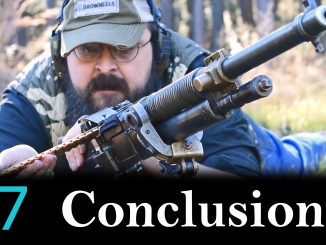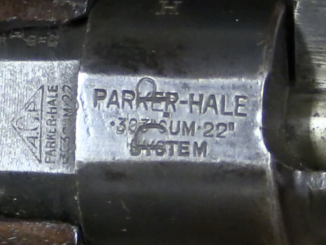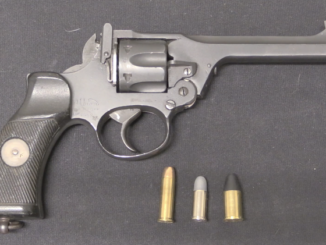This Vickers, Sons & Maxim 37mm MkIII “Pompom” is on display at the Canadian War Museum in Ottawa. The MkIII pattern is quite scarce, with less than one hundred ever made. It is built around the 37 x 124mm cartridge, firing a 1.25 pound explosive or armor piercing projectile. This one (or one of the same model) was mounted on the CGS Canada, a coastal patrol vessel built by VSM in 1904 for the Canadian Fisheries service. Firing fully automatically at 300 rounds/minute, the “pompom” (so named for the sound of its firing) was capable of tremendous firepower, although few ever saw much use in combat. Only the Boers made much use of them as land artillery, and by WW1 most were relegated to antiaircraft use.
© 2024 Forgotten Weapons.
Site developed by Cardinal Acres Web Development.




[OFF-TOPIC SO IGNORE IF YOU WISH]
Recently I read https://warspot.ru/15544-vintovki-colt-teper-tolko-dlya-voennyh that at September 18, it was announced that Colt will no longer produce AR-15 based rifles for civilian market.
This is quite surprising for me. But maybe other were actually excepted that?
Did manufacture of AR-15-like weapon become not competitive, when compared to newer patterns?
This has been in the US news a lot. Colt’s problem is that there are hundreds of companies making semi-auto ARs in the US and Colt is unable to compete on price against the likes of Anderson, Ruger, DPMS etc. and cannot compete on quality against BCM, Daniel Defense, Noveske, Seekins and FNH. So as a face saving move Colt is pulling out of the civilian market to focus on military and LE sales where there are fewer competitors. AR pattern guns are still very popular in the US, it’s just that Colt branded ones are unpopular.
Of course, this will be spun as a triumph of the Anti-Gun forces. See, the AR-15 is SO EVUL that even Colt has been shamed into no longer selling them to civilians
Blah blah
WRONG! WRONG! WRONG! Colt found itself outdone in popularity and economically efficient manufacturing techniques by its competitors. That’s why Colt withdrew from the AR-15 market.
Colt released a statement to clarify things, and it seems that they just got a $41 million dollar contract for M4’s, and that will take up their AR production capacity for the time being.
They are still selling other guns to the US civilian market, including concealed-carry type revolvers.
Reading between the lines, they can make a lot more money selling M4’s to governments than they can selling AR’s to a crowded civilian market. It is a completely logical decision. And probably, by briefly exiting the civilian market, Colt concluded that there would be at least a little pent-up demand for Colt AR’s when they reentered.
Unfortunately, the idiot news media latched onto it as some sort of omen of things to come. But, these days, it is difficult to form a sentence where the word “media” appears without the word “unfortunately” showing up nearby.
If you look back through Colt’s history, clear back to Sam Colt and the Paterson revolver, chasing government contracts has always been the company’s first priority. The civilian market has always been secondary for them, no matter what their ads claimed.
It was mainly Eli Whitney Jr. and Elisha Root before the Civil War, and C.B. Richards and William Mason after it, who put Colt in the civilian sporting and defensive arms business, because they understood that the only time the government alone would be a big enough market for their goods to sustain the company’s existence, let alone its profitability, was when there was an actual war being fought.
Sam Colt’s London operation was mostly an attempt to sell revolvers to Her Majesty’s Army and Navy for this exact reason. (Hint; Crimean War.) It proved to be no match for Deane, Adams, and Deane.
The present CEO of Colt is an ex-Army general who would prefer to deal with the government exclusively and not bother with the civilian market at all.
The main reason for the massive M4 contract is the short barrel of the M4 (12″/31.5cm)compared to the standard M16 (20″/51cm). It also has a shorter gas tube as a consequence, resulting in higher gas velocity and pressure blowing back into the bolt/concentric piston assembly. This causes increased bolt velocity, a higher cyclic rate even on burst setting, and thus faster wear and lowered MTBFs. Put simply, M4s wear out faster in service than full-sized M16s do.
And no, going to an external/parallel gas-piston instead of the present internal/concentric one probably wouldn’t help. Compare wear and MTBF rates on the regular-length Taiwanese Type 65 rifle and and the later short-barrelled Type 91 version, both of which use an FAL-type gas piston system.
cheers
eon
Colt has been overpriced and overvalued for years. Few people are buying their rifles when quality ARs can be had for half or less of the price of a Colt. Colt is letting dealers clear out inventory.
Exactly, Colt had difficulty competing in a huge market where you can get quality rifles in a wide variety of configurations and price points. They no longer had any monopoly on either quality or the design itself.
Also, in all fairness, Colt had been dogged for years by militant work force. It bears the fruit. Wondering it still exists.
By the way, it was the same work force which caused closing of USRAC. Blessed are those who move south.
With the original trio stopping AR-15 production, it will mean that they will only be seen in H3VR alongside competitors like the CMMG Banshee/Mutant/Guard, Barrett REC7, and Alexander Arms Beowulf.
On topic, how does this gun relate to the WWII Two Pounder?
If you mean the AA Pom-Pom then this is the same gun, more or less, just scaled up.
The Maxim Pom-Pom is relatively well-known. If you’re looking for a really Forgotten Weapon . . .
Hotchkiss also scaled up their gas-operated gun to 37mm (same ammo) in competition with Maxim, complete with huge feed strips. (Note this is a scale-up of the Odkolek design, NOT the much better known hand-cranked multi-barrel cannon)
Really hard to find info on this, beyond one photo of it during the Mexican Revolution.
Regia Marina during WWII also used (their own) up-scaled version of Hotchkiss gas-operated machine gun in caliber 37 mm:
Description: https://en.wikipedia.org/wiki/Cannone-Mitragliera_da_37/54_(Breda)
Photos (scroll to bottom): http://airwar.ru/weapon/guns/breda37-54.html
For some reason I can not link to navweaps articles (403 Forbidden), but this weapons is described there also. Go to:
http://www.navweaps.com
NAVAL WEAPONS
Italy
Historical Weapons
Smaller Caliber and Anti-Aircraft Guns
37 mm/54 Models 1932, 1938 and 1939
Scarce weapon with few customers… a pity nobody has uploaded blueprints to an archive yet.
For anyone interested in the Hotchkiss Pom-Pom, Google Books’ copy of the Revue d’Artillerie, Volume 59, does have a detailed, illustrated article on the piece, in French.
https://upload.wikimedia.org/wikipedia/commons/thumb/0/01/USSVixenMaximMachineGun.1898.ws.jpg/1200px-USSVixenMaximMachineGun.1898.ws.jpg
and
https://forum.ioh.pl/graficzki2/1227395398_3_7cm_maxim.jpg
and
https://i.ytimg.com/vi/6UPH04N22Zk/hqdefault.jpg
and
https://1.bp.blogspot.com/-nj4ghqX4id8/WutjYL9JioI/AAAAAAAAHHs/Vs6Lyrpjf6wFM_7pETPJYabIJhKET0vFgCLcBGAs/s1600/1915-Rolls-Royce-Armored-Car-Maxim-Pom-Pom.jpg
and
https://upload.wikimedia.org/wikipedia/commons/1/15/Australians_with_captured_German_pom-pom_Somme_16-08-1916_AWM_E03027.jpg
I have been four yards away when one of these was fired, a 40 round burst. Very impressive, the slow rate is somehow scarier than a fast firing autocannon.
Maybe this is because you can hear individual discharges, as though the gun itself is BARKING at you.
A few comments:
– The original Maxim 1 pdr pom-pom was chambered for the same 37 x 94R Hotchkiss ammo as various other guns.
– The Vickers 1 pdr Mk III (and Mk V) were much smaller and lighter guns chambered for a unique 37 x 69R round and intended for aircraft use. They saw little use.
– The was a bigger Maxim 1 1/4 pdr (later modified to the Vickers naval AA 1 1/2 pdr) which used a fatter as well as longer 37 x 124R case.
– The ultimate Vickers pom-pom was the 2 pdr naval AA gun, first used in 1915 and with the 1 1/2 pdr case lengthened and necked-out to 40 x 158R
-The USN adopted a “Heavy One Pounder” (Maxim variant) in a new 37 x 136R calibre, also used in the gas-operated McClean gun. The case was longer but more slender than the Vickers 1 1/2 pdr.
Great a childhood memory come to life.In 1964 my nana was being given a medal in Ottawa and we went up to see it presented.My dad being ex navy took me to the military museaum and it was this gun that impressed me most. I especially remember playing with the brass pistol grip. One photo and memories come flying back. Thank you so much Ian
Here’s the NAVWEAPS page on this gun
http://www.navweaps.com/Weapons/WNBR_1pounder_mk1.php